The Role of Negative Space in Modern Interiors
Using Negative Space For Impact In Modern Homes
In modern interior design, negative space is a key element. It helps make spaces look better and feel balanced. This empty space is not just a leftover; it’s a design choice that changes how we see and feel a room.
Interior designers use negative space to make rooms clearer and more focused. It helps move people smoothly through a space. This makes rooms feel open and calm, turning messy areas into peaceful spots.
Whether you like simple, clean designs or light, airy Scandinavian styles, negative space is crucial. It lets your design stand out, making your space look good and feel peaceful. By using negative space, you can make your home a calm and beautiful place.
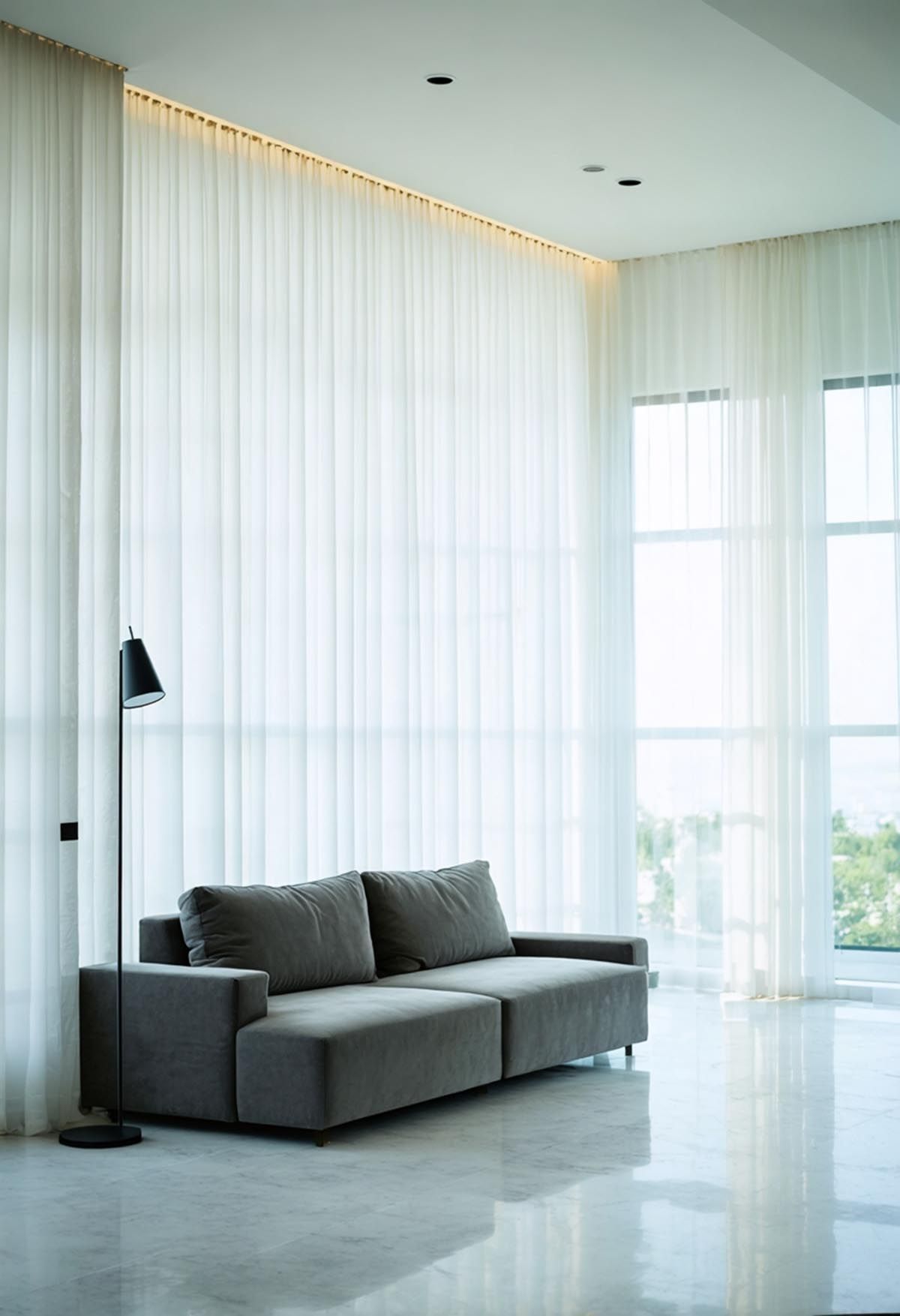
Understanding Negative Space in Home Design
In modern interior design, negative space is key. It’s the empty areas in a room that make it look good and feel calm. This empty space helps balance the room and makes it look open and peaceful.
Definition and Importance
Negative space is the empty area around the main parts of a room. It lets these parts stand out. It’s like the opposite of the filled-in parts, or positive space, which includes furniture and decor.
Using negative space right is vital for a balanced and eye-catching modern interior with negative space. It helps furniture look better and makes moving around easier.
Creating Balance in Spaces
Negative space frames the room’s best parts, making them stand out. It also makes the room feel more welcoming. Getting the mix of positive and negative space right is key to great home design.
| Benefit | Percentage |
| Improved Visual Comfort | 70% |
| Enhanced Aesthetic Appeal | 85% |
| Increased Productivity | 15% |
| Higher Customer Engagement | 20% |
Knowing how to use negative space makes homes look open and calm. It’s a way to create a space that feels good and looks great.
“The essence of interior design will always be about people and how they live. It is about the realities of what makes for an attractive, civilized, meaningful environment, not about fashion or what’s in vogue.” – Albert Hadley
The Psychology Behind Negative Space
Using negative space in home design can greatly affect how we feel. Experts say our surroundings can change our mood and how we see things. This is true for both our emotions and how we feel overall.
How Space Affects Mood
Things like balance and lighting in a room are key. Dave Alan Kopec , an expert in this field, says design affects our subconscious. It can change how we feel and what we think.
Designers use negative space to make rooms feel calm and balanced. This helps reduce stress and makes us feel more at ease.
The Calmness of Minimalism
- Minimalism, with its use of negative space, brings calm and peace to our homes.
- Dr. Sergio Altomonte says designing spaces with people in mind is vital for our health.
- Without clutter, we can focus better. This brings clarity and helps us concentrate.
- Environmental psychologist Migette Kaup notes that design can influence our behavior in different places.
Designers who understand negative space can make spaces that are calming and focused. This improves our overall well-being.
“Incorporating space psychology into design processes can enhance productivity in commercial projects, boost sales in retail, and expedite recovery in healthcare settings.”
Even though space psychology is crucial, there are no clear rules. Designers must use their creativity and knowledge to apply these ideas well.
| Negative Space Concept | Impact on User Experience |
| Micro white space | Impacts content legibility, affecting user reading speed and comprehension |
| Macro white space | Acts as a container for the overall design, contributing to the simplicity and calming effect of a layout |
By thinking about the psychology of negative space, designers can make spaces that are good for our well-being. These spaces help us feel calm and focused.
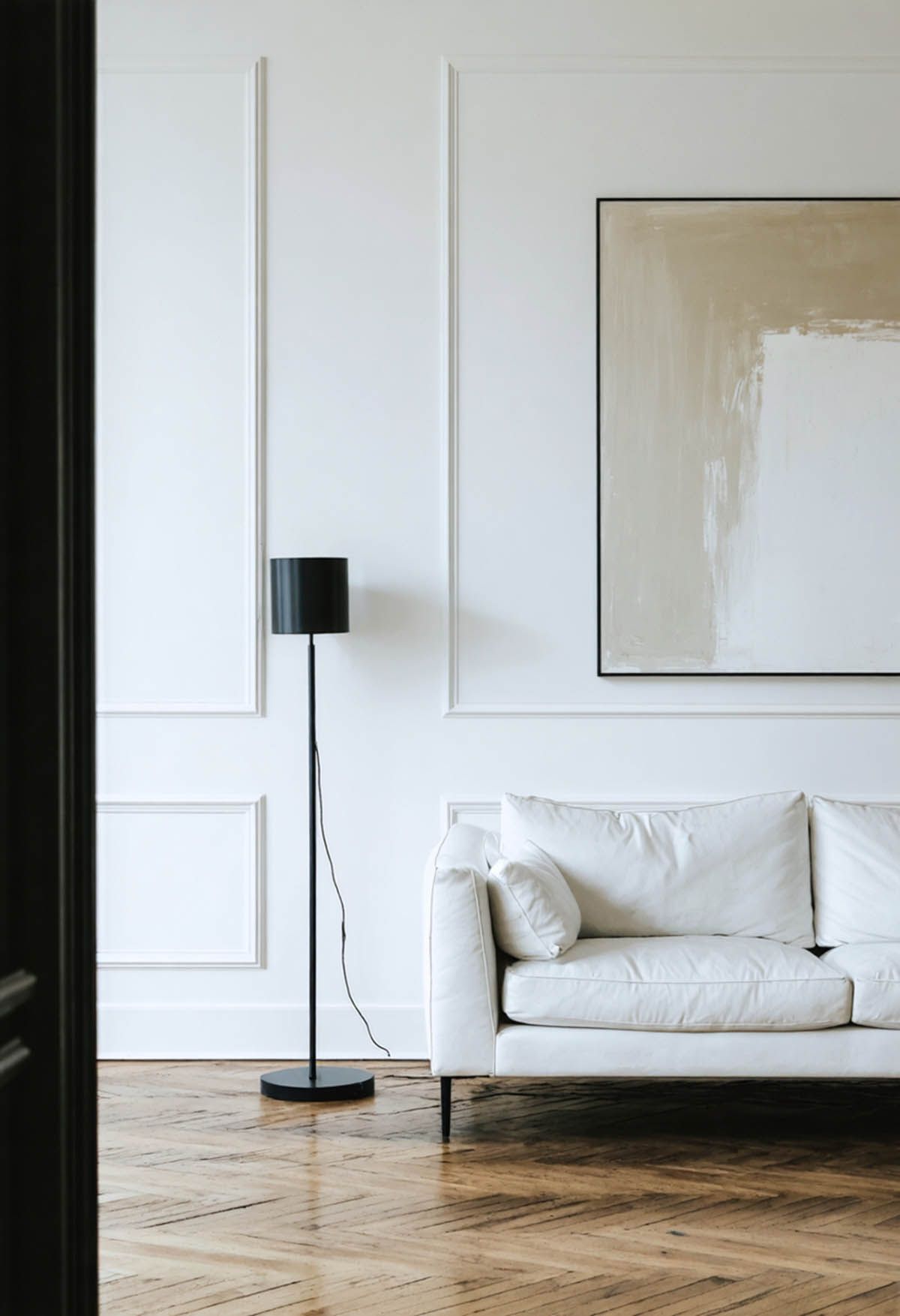
Incorporating Negative Space in Living Rooms
In modern interior design, using negative space can make your living room calm and beautiful. By picking and placing your furniture wisely, you can achieve balance and harmony. This makes the room look better overall.
To me, space is the ultimate luxury . Having space to just waste is divine! While my own home is very Bohemian in style, that’s because its an old house with lots of quirks and we don’t have the space to spare. However, if I built a home, everything would be oversize just for space. Like Demi Moore’s character says in Ghost when Patrick Swayze asks what to use the space for: she says “just space”!
Choosing the Right Furniture
When picking furniture for your living room, avoid big coffee tables that clutter the space. Choose sleek side or end tables instead. This lets the room’s architectural features, like big windows, stand out.
Arrangement Techniques
Placing furniture thoughtfully is crucial for negative space to work its magic. Set up your seating to allow for easy movement and open areas. This makes the room look better and work better too.
Also, leave some walls plain to show off their textures or treatments. This lets the room’s features be the focus. It brings calm and balance, making the room’s architecture the main attraction.
Using negative space in your living room design makes it modern, welcoming, and eye-catching. It shows off your style and creates a peaceful space for everyone to enjoy.
“Negative space is not just about what is absent, but about what is present and how it is perceived.” – Interior Design Expert
Experts say 56% of interior design pros stress the role of negative space in living rooms. It boosts the room’s look and function, making it more valuable.
By carefully choosing your furniture and layout, you can make a space that’s both beautiful and functional. It highlights the beauty of modern design with negative space.
The Use of Negative Space in Kitchens
In modern kitchen design, negative space is a big deal. It turns kitchens into calm, sophisticated places. The trick is finding the right mix of positive and negative elements.
Open Concepts and Flow
Using less upper cabinetry and more lower storage is key. It makes the kitchen feel airy and lets pendant lights shine. An open layout improves room flow and makes kitchens look bigger and more inviting.
Maximizing Storage with Space
Less upper cabinetry means more efficient storage. Homeowners can use lower spaces better, keeping the kitchen open. This also lets in design touches like open shelves, adding to the kitchen’s look.
Negative space in kitchen design is powerful. It changes how kitchens look and work. In Australia , it helps homeowners create peaceful, stylish kitchens that show off their taste.
“The use of negative space in kitchen design can be a game-changer, allowing homeowners to create a sense of lightness and serenity while maximizing storage and functionality.”
Designing Functional Bedrooms with Negative Space
Using negative space in your bedroom can greatly enhance its feel. By placing furniture and accessories thoughtfully, you can achieve balance and calm. This promotes relaxation and rest.
Bed Placement Strategies
Where you place your bed is key to using negative space well. Place it against a bare wall for easy movement and to make the room feel bigger. This also makes your bed the room’s focal point.
Don’t overdo it with wall art or shelves. Too much can make the room feel cluttered and disrupt the flow.
Choosing Accessories Wisely
Be careful with the accessories you choose for your bedroom. Pick a few standout pieces, like a pendant light or vase, instead of filling every inch. This lets your eye rest and brings tranquility.
Also, think about using furniture that’s transparent or minimalist, like the Frame Armchair from Made.com. This helps make the space feel more open.
| Design Element | Positive Space | Negative Space |
| Bed Placement | Centered in the room with ample space around it | Bare walls behind the bed, allowing the space to breathe |
| Wall Decor | Minimal, focused on a few key pieces | Uncluttered walls create a calming atmosphere |
| Furniture Selection | Lightweight, transparent pieces like the Aula Brass & Glass Table | Generous space between furniture pieces, enhancing the perception of openness |
By balancing positive and negative space in your bedroom, you can create a peaceful retreat. The beauty of negative space is that it lets your chosen furnishings and accessories stand out. This way, your personal style can truly shine.
Impact of Negative Space in Bathrooms
Bathrooms can become peaceful, spa-like places with negative space. Using asymmetry and lighting wisely creates a calm atmosphere. This lets the eye relax and the mind unwind.
Creating a Spa-Like Environment
Adding negative space to bathrooms makes them feel luxurious and calm. Asymmetrical designs, like off-center mirrors or single pendant lights, add interest. They keep the space open and airy.
These designs break the usual symmetry. They draw the eye to certain spots, creating a balance. This balance brings a spa-like feel to the bathroom.
Effective Use of Lighting
Lighting and negative space work together to improve the bathroom’s feel. Soft wall sconces, recessed lights, or a standout pendant light add gentle light. This light makes the space feel open and peaceful.
This balanced lighting creates a calm, meditative space. It helps the mind relax and drift into a peaceful state.
Using negative space in bathrooms turns them into modern interiors with negative space. They feel calm and sophisticated. This design not only makes the space look better but also creates a peaceful, spa-like experience. It’s a great escape from daily stress.
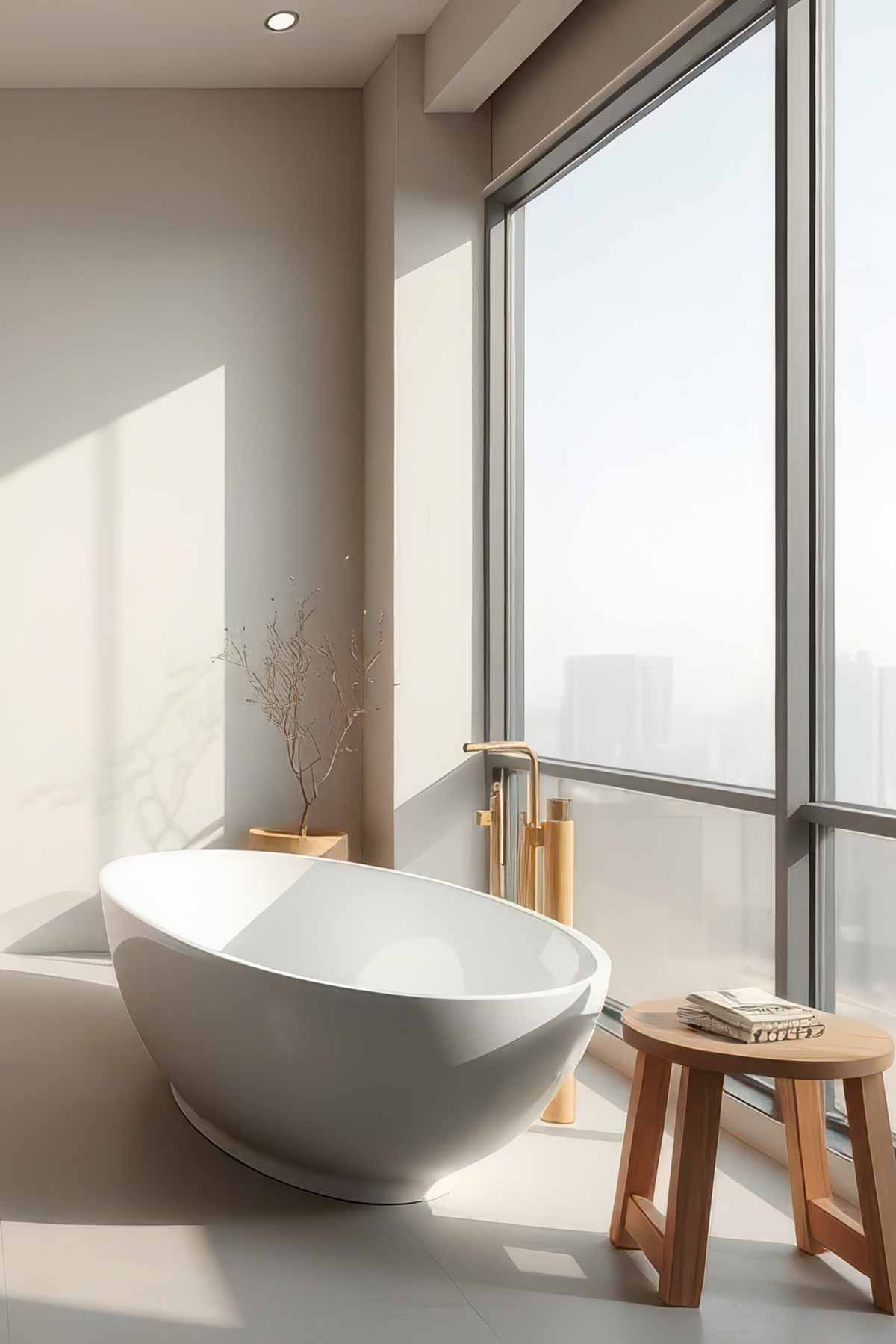
Office Spaces and Negative Space
In the world of open space design, using negative space can really help focus and productivity in offices. It reduces visual clutter and distractions. This creates a calm, organized space where employees can do their best.
Enhancing Focus and Productivity
Placing furniture and decor carefully can make a workspace clean and free from distractions. Negative space brings clarity and peace, letting people focus better without being bothered by their surroundings.
Ergonomics and Layout
When designing offices with negative space, think about ergonomics and how things flow. Arrange workstations, storage, and areas for teamwork well. This makes the office work better and supports health and productivity. Using negative space wisely can make an office more functional, leading to a better work culture and better work.
“Negative space is not just about emptiness; it’s about balance, harmony, and the creation of a purposeful, focused environment. When applied thoughtfully in office design, it can unlock new levels of creativity and innovation.”
As businesses grow, the need for well-designed offices with negative space becomes clearer. By finding the right mix of positive and negative elements, designers can make spaces that boost productivity, teamwork, and calm. This helps the whole organization succeed and thrive.
Negative Space in Entryways
The entryway is key in home design. It’s where visitors first see your home and sets the mood for the rest. Using negative space in entryways makes your home look welcoming and eye-catching.
First Impressions Matter
The entryway is your home’s first greeting to the world. Using negative space wisely can make it more impactful. Don’t fill it with too much stuff. It can make the space feel cramped.
Instead, use empty spaces to show off cool features like a beautiful staircase or unique floors. These can grab your guests’ attention right away.
Welcoming Ambiance
A well-designed entryway with negative space feels warm and open. It lets in lots of light and makes room for movement. This creates a cozy vibe that welcomes everyone.
Adding the right lighting or art can make the space even more inviting. It draws the eye and makes a statement.
Negative space in entryways is a big deal in home design. It helps create a great first impression. This impression makes your home feel special and inviting to all who visit.
Outdoor Spaces and Negative Space
Designing your outdoor areas with negative space can change the game. It turns your patio, garden, or backyard into a beautiful oasis. This concept makes your space look and feel amazing.
Incorporating Nature
Outdoor spaces are perfect for negative space. Leaving some areas open lets your living space blend with nature. It’s great for showing off views, water features, or outdoor art.
Open Patios and Gardens
In your outdoor areas, furniture and landscaping define spaces. A well-placed patio or a fire pit can make your space inviting. Gardens with open paths and structured beds also look great.
A serene outdoor space featuring an open concept design, emphasizing negative space through minimalistic furniture arrangements, lush greenery, and unobstructed views of nature. Incorporate a harmonious balance between structure and surrounding environment, showcasing soft sunlight filtering through trees and creating inviting shadows on a wooden deck.
AV Architects + Builders use negative space in their designs. They mix minimalism with contrast to create peaceful outdoor spaces. These spaces feel calm and connect you with nature.
| Positive Spaces | Negative Spaces |
| Patio seating areas | Open pathways |
| Structured garden beds | Expansive lawn spaces |
| Architectural features | Framed views of nature |
Using positive and negative spaces in your outdoor design makes a big difference. It creates a space that’s inviting, peaceful, and connects you with nature.
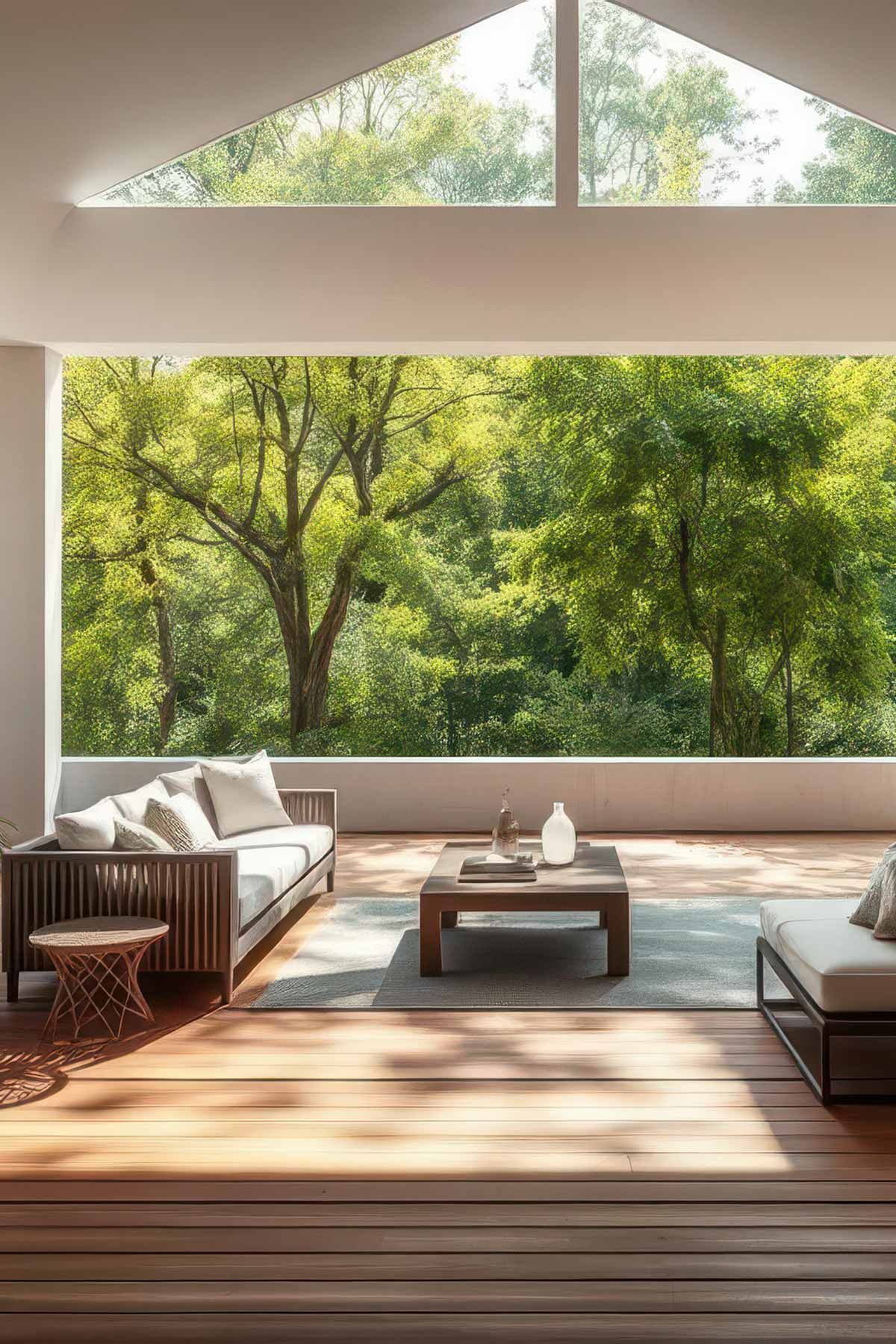
Common Mistakes to Avoid
Using negative space in home design is powerful, but there are pitfalls to watch out for. To create a balanced and beautiful space, avoid these mistakes.
Overcrowding Spaces
One big mistake is putting too much furniture or decor in a room. Interior designers say that pushing furniture against walls can make a room feel tight. Liz Williams from Liz Williams Interiors notes that blocking paths can make a room feel cramped.
Ignoring Natural Light
Another mistake is not considering natural light. Interior designers warn against too many focal points in a room, as it can look chaotic. They suggest keeping focal points few to ensure natural light flows well. Using only overhead lighting can make a room feel harsh, so add table lamps and sconces for warmth.
- Avoid filling every corner with furniture or decor to prevent clutter.
- Think about how furniture placement affects room flow, keeping paths open.
- Use furniture and decor to let natural light spread across the room.
- Use different lighting sources, like table lamps and sconces, for a cozy feel.
By avoiding these common mistakes, you can use negative space to make your home both beautiful and functional.
Trends in Negative Space Design
In Australia, people are loving modern interiors with lots of empty space. They’re drawn to minimalist styles, which focus on simple lines and clean areas. This lets the eye relax and enjoy the chosen furniture and decor.
Current Styles to Consider
Open-plan living is big now, with big, open areas instead of walls. It makes homes feel bigger and looks better. Big art pieces are also popular, with empty space around them to make them stand out.
Future Predictions in Home Design
Experts think wellness-focused design will keep growing, with negative space being key. It helps make homes calm and peaceful. Technology will also blend with negative space, making homes both modern and relaxing. As homes change, negative space will stay important, making them look great and feel good.
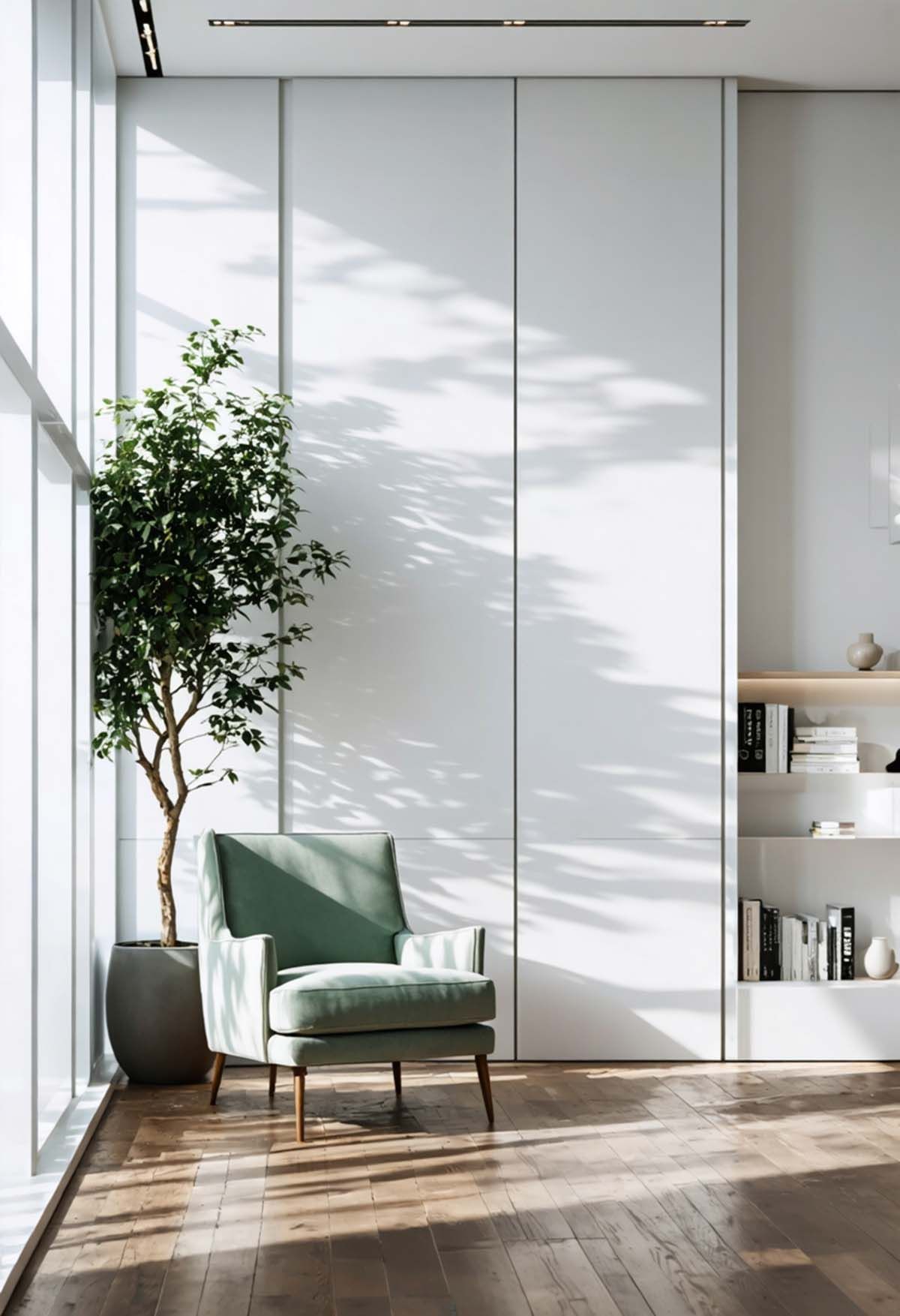
FAQ: Using Negative Space The Right Way
What is negative space in interior design?
Negative space is the empty area in a room. It can be on walls or floors. It helps balance the room and makes focal points stand out.
Why is negative space important in modern interiors?
It makes key design elements pop and adds calm to modern spaces. It works in any style and size, making spaces look better.
How can negative space affect the mood and perception of a living space?
It brings comfort and harmony, reducing sensory overload. Using negative space in minimalism makes spaces calm and peaceful.
How can negative space be incorporated in living rooms?
Use it by choosing and arranging furniture wisely. Remove traditional pieces like coffee tables to show off the room’s features.
What are the benefits of using negative space in kitchen design?
It’s created by using less upper cabinets and focusing on lower storage. This opens up the space and highlights features like pendant lighting.
How can negative space be utilized in bedroom design?
Place the bed strategically and use minimal wall decor. Leave some walls bare to create calm and highlight special pieces like artwork or a statement headboard.
How can negative space enhance the design of bathrooms?
It makes bathrooms feel like spas. Use asymmetrical layouts and lighting to improve the look and feel of the bathroom.
How can negative space improve office design and productivity?
It helps focus and productivity by reducing distractions. Place furniture carefully and use minimal decor for a clean, organized workspace.
How can negative space impact the design of entryways?
It makes entryways welcoming. Use negative space to highlight architectural features and set the home’s tone.
How can negative space be incorporated in outdoor spaces?
Outdoor spaces are perfect for negative space. Leave areas open for plants or views to create inviting spaces that blend with nature.
What are some common mistakes to avoid when using negative space in interior design?
Avoid overcrowding with furniture or decor and ignore natural light. Too much in display cabinets or walls can clutter and lessen the impact of pieces.
What are the current trends and future predictions in negative space design?
Trends include minimalist styles, open-plan living, and large art pieces. The future will focus on wellness, with negative space creating calm, clutter-free spaces.

About The Author
I'm Channing and I am the driving force behind Platypus and Pine. I've had over 30 years of experience in designing, renovating and customising Australian homes.
I've used everything from aluminium to velvet as decor choices and love a wide variety of styles and themes.
My absolute favourite is Mid Century Modern and I was fortunate enough to spend 2 weeks in Palm Springs for Modernism week just last year.
